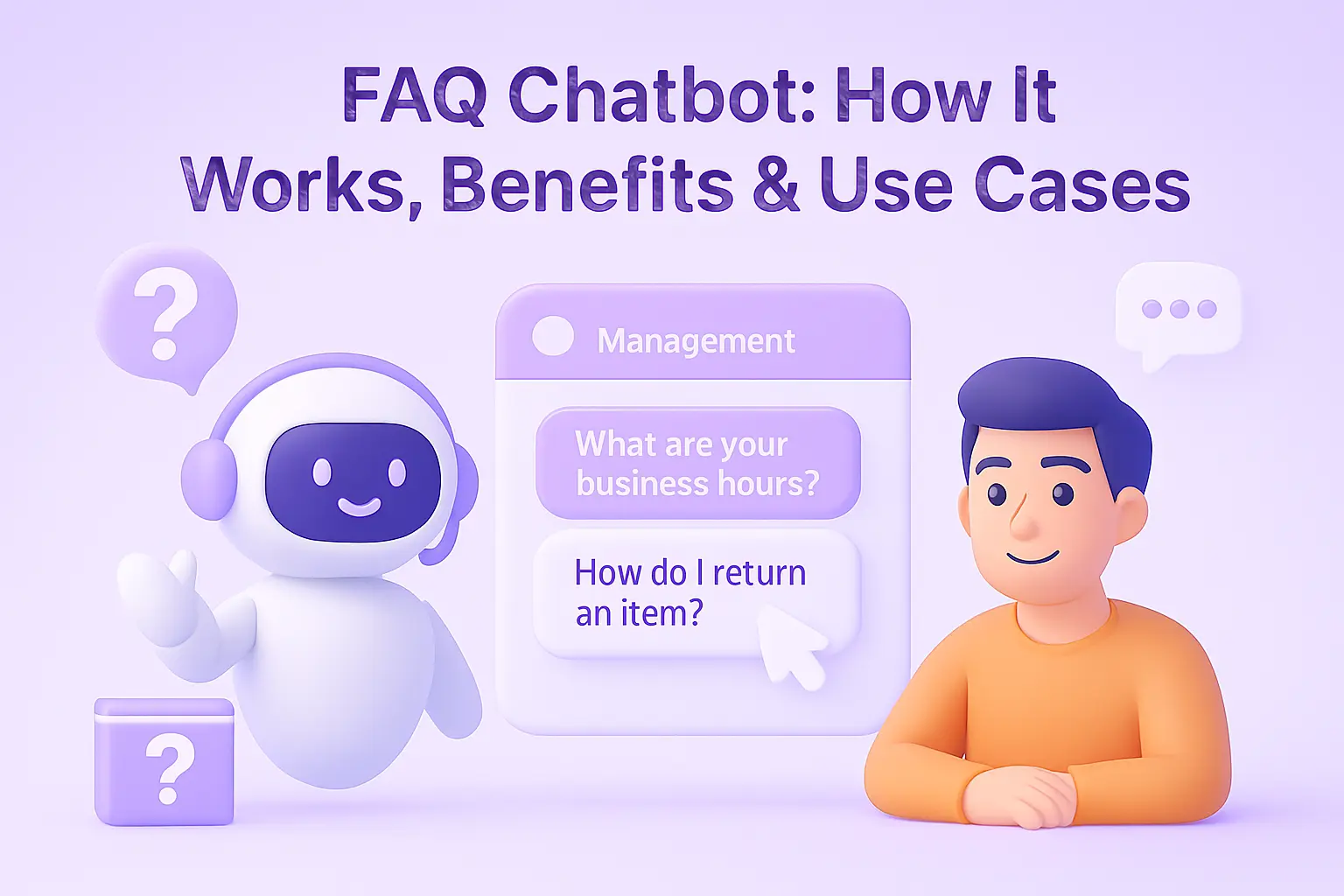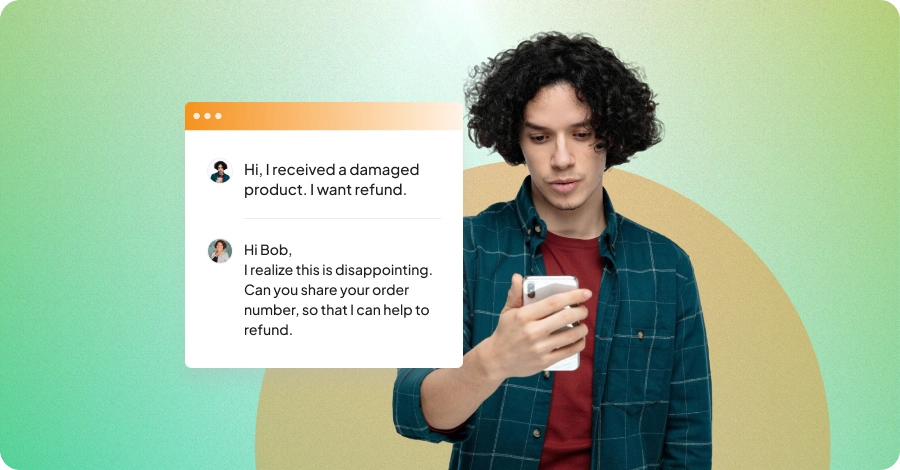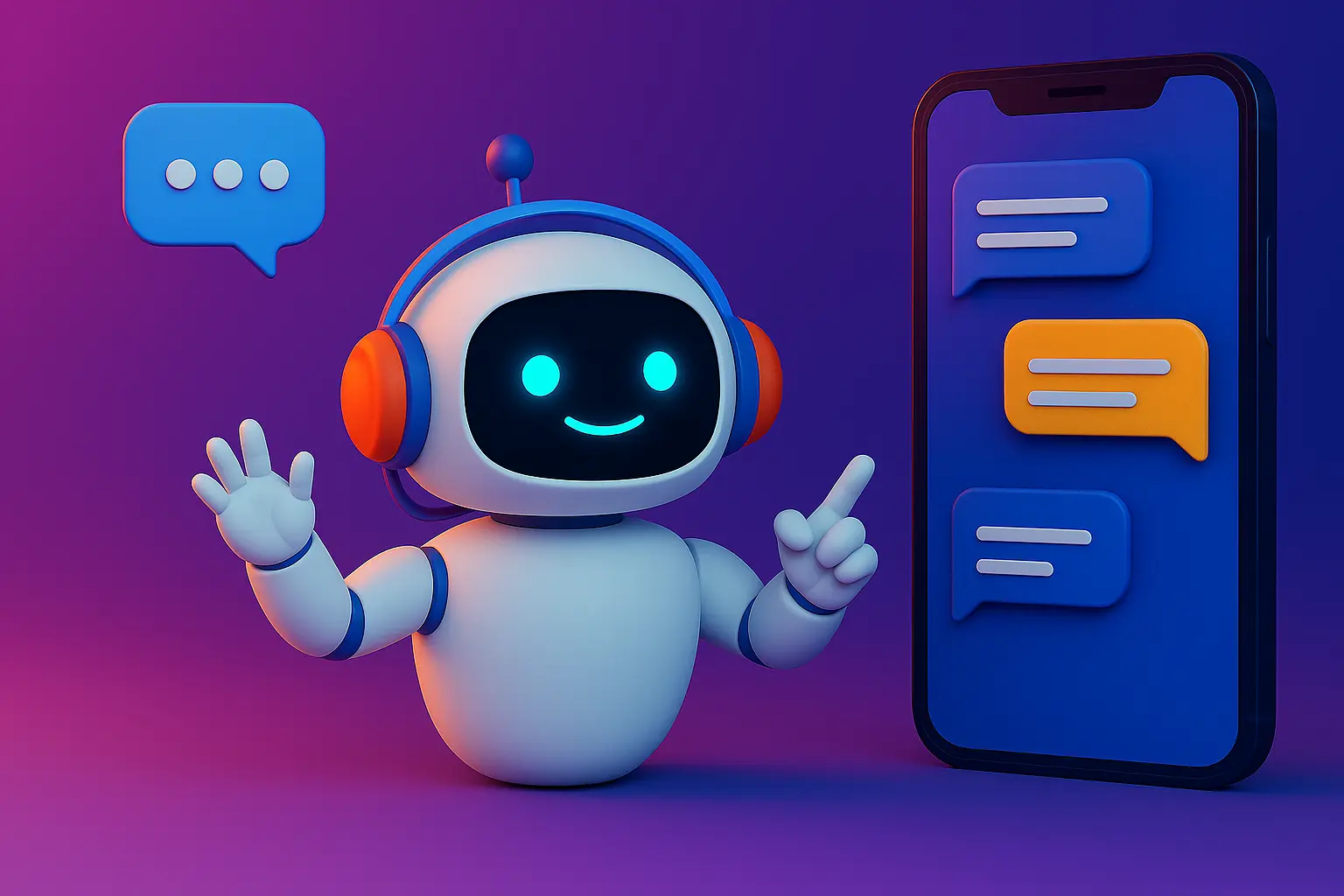Voicebot Vs Chatbot: Which One Should Your Business Use?
- May 8, 2023
- 15 mins read
- Listen

Are you planning to use chatbots and voice bots to enhance your customer support process, but are confused about which one would be the most appropriate for your business and team? ‘Voicebot vs Chatbot’ is a great topic worth discussing. Keep reading this space to get some insights.
In the 21st century, artificial intelligence has become an essential building block of technological progress. It underpins a wide range of innovations, from intelligent speakers to self-driving vehicles. What makes AI remarkable is its capacity for ongoing learning and self-adaptation, enabling it to function independently.
In the past decade, the development of AI has progressed rapidly, and its adoption rate has been swift. According to Statista’s report on artificial intelligence, about 75% of businesses are expected to invest in AI-powered technologies by 2027.
Artificial intelligence has changed the way we look at any business by enabling the automation of tasks through the use of AI assistants. Chatbots and voicebots are prime examples of AI-powered technology that have transformed the way companies interact with customers. These clever bots can help you in delivering exceptional customer experiences, as opposed to negative ones.
In this blog post, I shall provide an in-depth analysis of the main distinctions between voice bots and chatbots, so that you have the knowledge to make a well-informed decision on which one best suits your business.
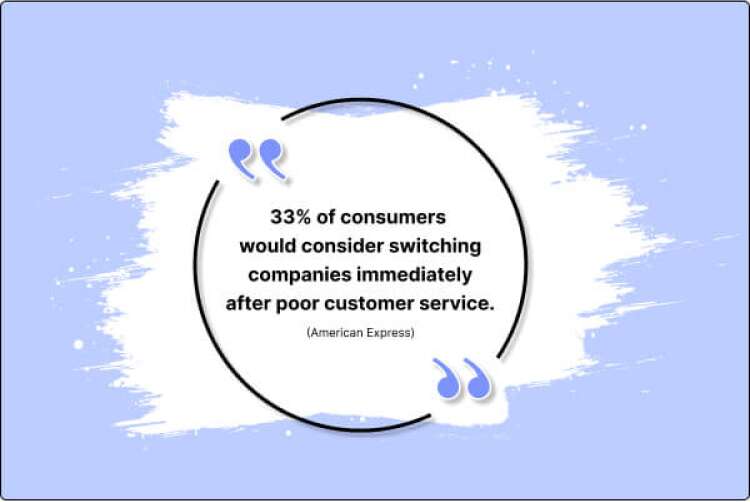
What is a Chatbot?
“A chatbot is a software program designed to engage in text-based online conversations, serving as a substitute for direct interaction with a human representative.”
So, basically, a chatbot is a virtual assistant that allows us to interact with technology. The term “chatbot” originated from the fact that early bots developed in the 1960s were primarily text-based.
These automated bots leverage natural language processing (NLP) technology to comprehend and address our inquiries and offer useful replies, rendering them well-suited for different companies that favor text-based communication.
A significant benefit of chatbots is their capacity to offer round-the-clock customer support. In contrast to human customer service agents, chatbots can promptly respond to user inquiries, regardless of the hour.
You can easily integrate chatbots with your company websites, mobile apps, and other messaging platforms like Facebook, Instagram, Telegram, Viber, WhatsApp, and so on. In customer interactions, a chatbot can facilitate high-quality self-service for your company.
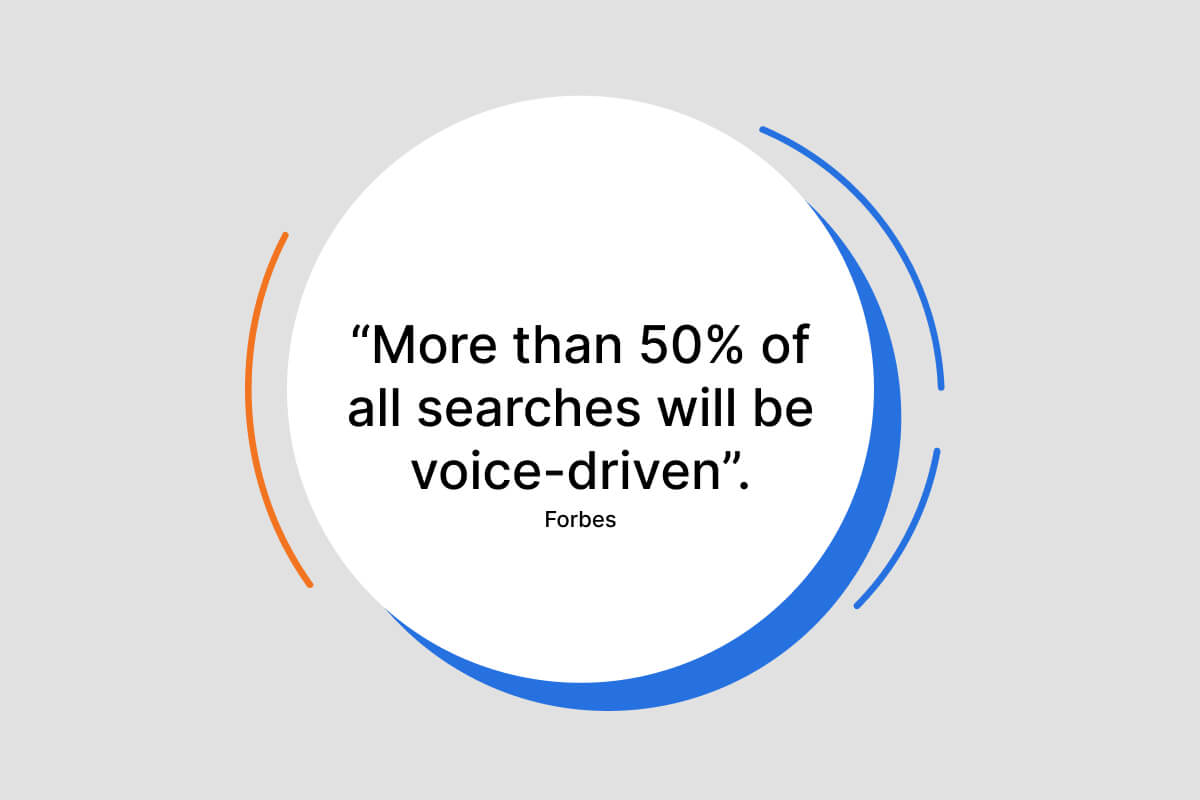
Know more: A comprehensive guide to chatbot
What is a VoiceBot?
Automated systems known as voicebots or voice assistants can engage with us via voice commands. Through the use of natural language processing (NLP) technology, these bots can comprehend and react to our voice commands, enabling us to perform tasks without the need for a keyboard or touchscreen.
Let me give you an example here.
Suppose a restaurant employs a voice bot to handle food orders. In that case, when a customer places an order by calling and interacting with the voice bot, the bot, with the help of NLP and AI, carries out the following actions:
- Convert the customer’s spoken words into text.
- Formulate a response in text format.
- Convert the text response into speech, which is then relayed to the customer.
All of this occurs within a matter of seconds, creating an experience for the caller that is similar to speaking with a human agent.
Natural Language Processing (NLP) and Automatic Speech Recognition (ASR): The Building Blocks of Conversational AI
Before we explore the differences between voice bots and chatbots, let’s first focus on their significant commonality. That is the employment of natural language processing (NLP) technology in facilitating interactions between users and the bots. However, voice bots take it up a notch by utilizing automatic speech recognition (ASR) technology.
NLP, which is a form of AI, enables bots to communicate with us using natural language in a smooth and effortless manner. As more investment is being poured into this state-of-the-art technology, it is projected that the NLP market will expand by 14 times its size in 2017 by the year 2025.
This is how NLP operates: It compares the input it receives with a vast dataset it has been trained on to recognize parts of speech and segment it into smaller units. Next, it examines how these various segments could potentially interact with one another to create meaning. Within NLP, there is a subcategory called natural language understanding (NLU), which empowers computers to comprehend the intentions behind messages and become more intuitive.
Although NLP is beneficial for both chatbots and voice bots, voice AI goes a step further by employing automatic speech recognition (ASR). ASR assists in dissecting intricate human speech into smaller, more manageable fragments that can be processed and comprehended by the algorithm.
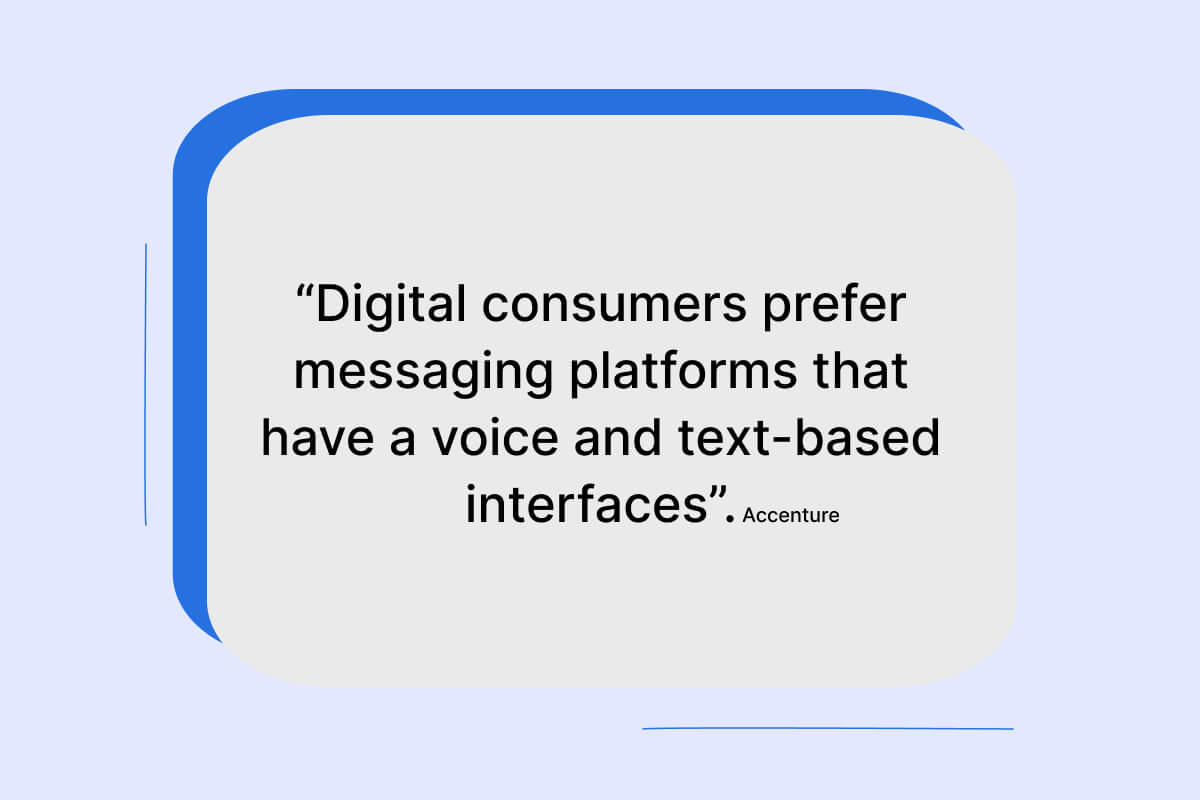
Battle of the Bots: Voicebot vs. Chatbot
By integrating an AI assistant into your website, you can significantly enhance your customers’ experience, provide support to your team when dealing with a high volume of calls, and offer uninterrupted customer service 24/7.
However, when considering which option to choose for your business, the question arises as to whether you should opt for a voice bot or a chatbot. The primary distinction between these two types of AI assistants is that voice bots operate on voice commands, whereas chatbots do not.
Let’s explore the strengths that both of these conversational AI bots offer.
The Case for Voicebots: Why They Outshine Chatbots
In the battle of voice bot vs chatbot, voice bots offer several advantages over chatbots, making them a popular choice in the realm of conversational AI. Here are some reasons to look into.
1. Use Voice for Better Communication
Voice bots allow us to communicate directly with the AI through speech, making it a suitable option for individuals of all ages and backgrounds. Its user-friendly nature ensures that even those who are not particularly tech-savvy can easily use the bot and have an excellent user experience.
Voice bots have the capability to process voice commands and respond to them quickly, providing a seamless and efficient user experience. Here we can simply speak out our requests or queries, eliminating the need for typing and reducing the time required to complete the task. This feature is particularly useful for individuals who prefer a hands-free approach or those who may have difficulty typing, such as those with disabilities.
In contrast, chatbots require us to type out our requests, which can be time-consuming and tedious. Therefore, the use of voice bots can enhance user satisfaction and improve the overall efficiency of the conversational AI experience.
2. Improved Customer Engagement
Voice bots operate in a manner similar to how you would communicate with someone through a phone call, WhatsApp, or other messaging applications.
Voice bots allow for more engaging conversations with your customers, as they can respond in a conversational tone and provide personalized responses based on the user’s voice and tone. This personalized touch makes the user feel heard and understood, which can lead to higher levels of engagement and satisfaction.
Moreover, voice bots can also provide a more immersive experience, as they can use sound effects and other audio cues to create a more interactive and engaging experience. This is especially useful in situations where we need to be guided through a process or are looking for specific information.
In contrast, chatbots can sound robotic in some cases, as they often use pre-written responses and lack the ability to respond in a conversational tone.
3. Greater Integration
Voice bots can be integrated with a wider range of systems and applications. This is because voice bots rely on voice recognition technology, which can be integrated with a variety of tools and platforms. For instance, voice bots can be integrated with voice assistants like Siri or Alexa, enabling us to access information and perform tasks hands-free.
Voice bots can also be integrated with other technologies like natural language processing (NLP), speech-to-text conversion, and machine learning algorithms, which can improve their accuracy and effectiveness over time.
By integrating your voice bot with your CRM or making it accessible through smart speakers, your clients can conveniently communicate with your AI voice bot directly from their homes. This integration enables a seamless and engaging consumer experience, improving the overall effectiveness of your conversational AI solution.
In Defense of Chatbots: Why They’re Still Relevant in a Voice-First World
There is a growing trend toward voice-based technology and conversational AI, but that doesn’t mean that chatbots are no longer relevant. Here are some reasons why chatbots are still important in a voice-first world:
1. Better User Experiences
For online communication, one of the key advantages of chatbots is that they can offer a better user experience than voice bots in certain situations.
For instance, chatbots can provide a more visual and interactive experience for users, as they can display images, videos, and other multimedia content. This can be especially useful in industries such as fashion, where customers may want to see images of products before making a purchase.
Chatbots can also offer a more personalized experience for us, as they can track our previous interactions and tailor responses based on user history and preferences. This can help build stronger relationships with customers and improve overall satisfaction.
Additionally, chatbots can offer a more efficient experience for your customers, as they can provide quick and accurate responses to queries without requiring lengthy voice-based conversations. This can be especially useful in situations where customers may be in a rush or have limited time to communicate.
2. Easier to Train
Chatbots can often be developed and trained more easily, as they rely on text-based communication. This makes it easier to prototype and test a chatbot, as developers can quickly iterate and refine the bot’s responses based on user feedback.
But developing a voice bot can be a complex and time-consuming process, as it requires creating and training a machine learning model that can accurately interpret and respond to voice commands. This can require a large amount of data and specialized expertise.
Additionally, chatbots can be more flexible in terms of language support. While voice bots may struggle to interpret different accents and dialects, chatbots can be programmed to understand a wide range of languages and dialects, making them more accessible to a global audience.
3. Increased Use of Audiovisual Materials
Chatbots have the ability to communicate not only through text but also through audio-visual content such as images, videos, and GIFs. This makes the overall user experience more engaging and interactive compared to voice bots, which are limited to audio-based media.
Chatbots can display product images or even provide video tutorials on how to use a product or service, improving the user experience and making it more engaging.
Additionally, the use of audiovisual materials can help chatbots better convey complex information to users. For example, a chatbot for a healthcare provider could use videos or infographics to explain complex medical procedures or conditions, making the information more understandable and accessible to patients.
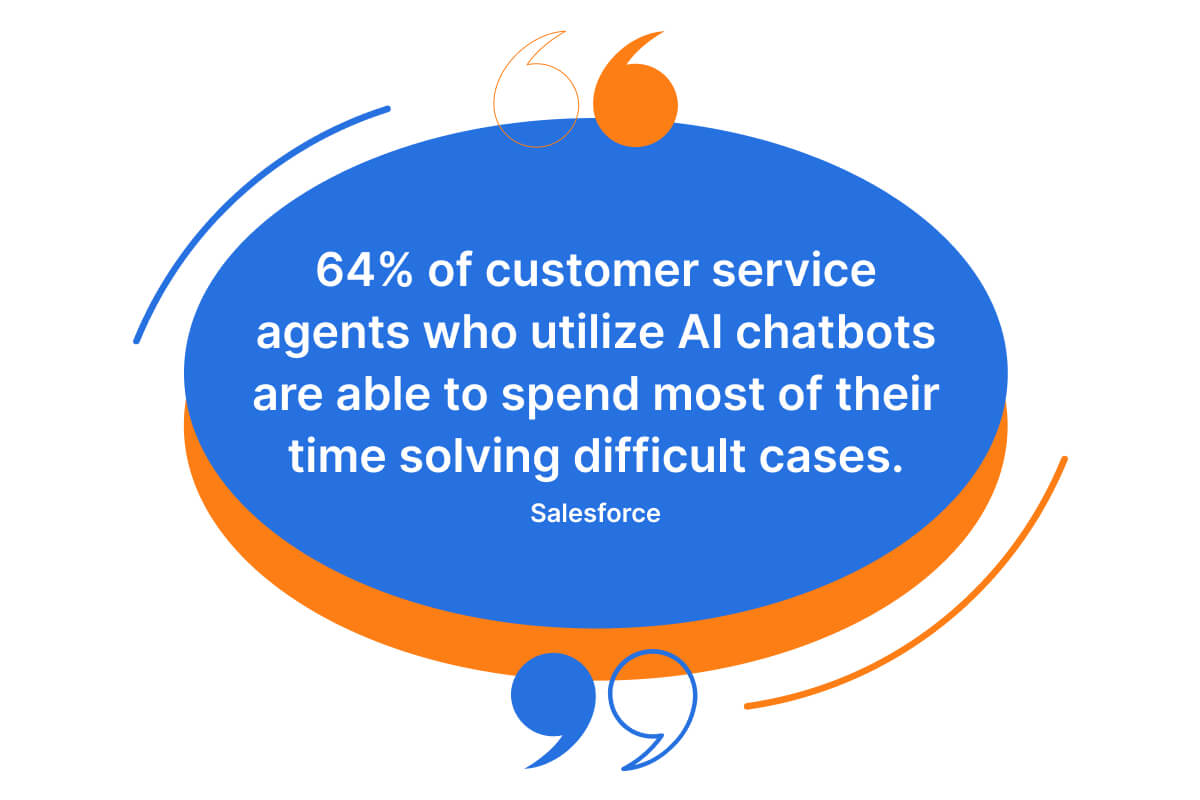
Deciding Between Voicebots and Chatbots: Factors to Consider
While making a decision about which bot to choose for your business, it’s important to take into account various factors such as your company requirements, target audience, and objectives. Below are some crucial factors to keep in mind while selecting the most appropriate bot for your business:
Industry Type
Different industries require different types of bots. For instance, in sectors such as healthcare or hospitality, where personalized and hands-free experiences are critical, voice bots may be more fitting. On the other side, in industries such as eCommerce or finance, where prompt and precise responses are the primary requirement, chatbots may be more appropriate.
Audience Demographics
Determining which bot to opt for may also depend significantly on your target audience.
If your target audience consists mostly of younger generations who are at ease using voice assistants such as Alexa or Google Assistant, then a voice bot might be the optimal choice. On the other hand, if your target audience prefers text-based communication, a chatbot may be more fitting.
Business Requirements
It’s important to think about the tasks you want the bot to handle and the kind of customer support you wish to offer. If your business demands speedy and efficient responses to customer inquiries, then a chatbot could be the most appropriate choice.
Nevertheless, if you intend to deliver a more individualized and hands-free experience, then a voicebot may be better suited to your needs.
Financial Resources
Budget is a vital consideration when deciding between voice bots and chatbots.
Implementing a voicebot may entail using advanced technology, such as high-quality voice recognition, which can be expensive. Such bots require more advanced technology and specialized hardware, such as microphones and speakers, which can increase implementation costs. In contrast, chatbots may be less expensive to develop and launch since they do not require hardware.
On the other hand, voice bots may require ongoing maintenance and updates to ensure optimal performance, which can lead to higher maintenance costs. Chatbots may require less maintenance, making them more cost-effective over time.
Task Complexity
The complexity of the tasks that the bot needs to handle is another factor to consider when choosing between voice bots and chatbots. While both types of bots can handle simple tasks, voice bots may be more appropriate for complex tasks that require a more personalized and hands-free experience.
Also, consider whether the bot needs to integrate with other systems, such as a CRM or payment gateway, to perform complex tasks. Voice bots may be more difficult to integrate with other systems than chatbots.
Ultimately, the decision on whether to choose a voice bot or chatbot will depend on your specific business requirements and objectives. Both options have their advantages and limitations, and the selection will depend on which type of bot aligns better with your business needs.
Chatbot vs Voicebot: The Key Differences
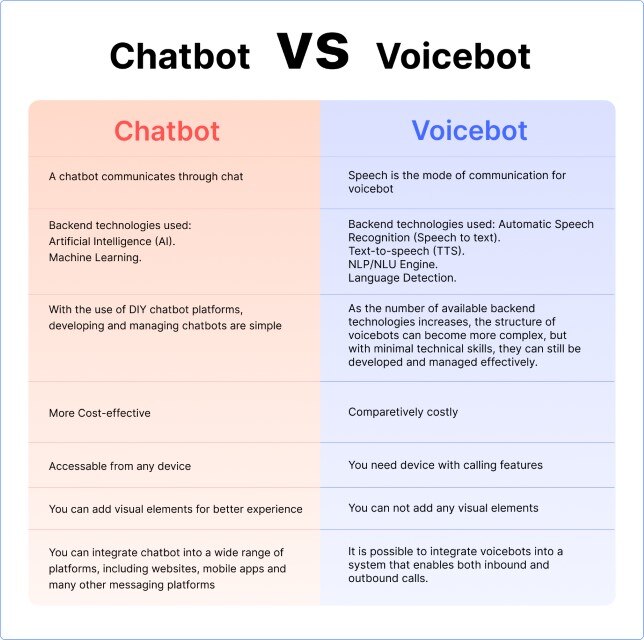
| Chatbot | Voicebot |
|---|---|
| A chatbot communicates through chat | Speech is the mode of communication for a voicebot |
| Backend technologies used: Artificial Intelligence (AI), Machine Learning | Backend technologies used: Automatic Speech Recognition (Speech to text), Text-to-speech (TTS), NLP/NLU Engine, Language Detection |
| With the use of DIY chatbot platforms, developing and managing chatbots is simple | As the number of available backend technologies increases, the structure of voicebots can become more complex, but with minimal technical skills, they can still be developed and managed effectively |
| More cost-effective | Comparatively costly |
| Accessible from any device | You need a device with calling features |
| You can add visual elements for a better experience | You cannot add any visual elements |
| You can integrate a chatbot into a wide range of platforms, including websites, mobile apps, and many other messaging platforms | It is possible to integrate voicebots into a system that enables both inbound and outbound calls |
Some Examples: Voicebots
In this section, we will examine the top 3 AI voice bots for your better understanding.
- Amazon Alexa: Alexa is a popular voice bot developed by Amazon that allows users to interact with various devices using voice commands.
- Google Assistant: Google Assistant is a voice bot developed by Google that can perform tasks such as setting reminders, answering questions, and controlling smart home devices.
- Apple Siri: Siri is a voice bot developed by Apple that is available on iOS devices. It can perform tasks such as setting different reminders, sending messages, and making phone calls.
Some Examples: Chatbots
- REVE Chatbot: The REVE Chatbot is an AI-based customer Support System designed to automate all your customer support requests and other business operations. This chatbot can assist with everything from signup to post-sales, enabling businesses to enhance their customer satisfaction, drive website traffic, and improve the quality of leads generated.
REVE Chatbot can be integrated with your website, mobile app, and other messaging platforms like Facebook, Instagram, Telegram, Viber, and WhatsApp. REVE Chat offers a 14-day FREE TRIAL to try out all its unique features. So, SIGN UP today. - Facebook Messenger Bot: Facebook Messenger Bot is a chatbot developed by Facebook that allows businesses to communicate with customers through the Facebook Messenger app.
- Talla: Talla is an AI-powered chatbot platform designed for enterprise companies. It integrates with popular collaboration tools like Slack and Microsoft Teams, enabling employees to interact with the chatbot seamlessly without leaving the familiar interfaces they use for their work. Talla’s chatbot uses natural language processing and machine learning to automate various tasks, including answering common questions, scheduling appointments, and providing personalized recommendations.
Over to You!
In conclusion, both voice bots and chatbots have their unique advantages and can be useful in different scenarios. Voice bots are excellent for hands-free interactions, while chatbots provide you with a seamless user experience across various messaging platforms. Ultimately, the decision to use a voice bot or chatbot will depend on your business’s specific needs, goals, and target audience.
As AI technology continues to evolve, we can expect to see even more innovative solutions that combine the benefits of both voice bots and chatbots. Regardless of which technology is used, implementing an AI-powered bot can help businesses automate their operations, enhance customer satisfaction, and drive growth in today’s digital age.

